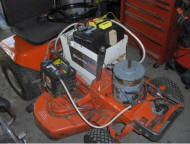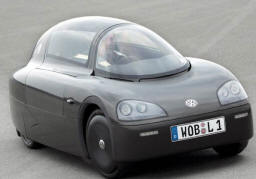Monday, August 31, 2009
August Performance for the $1K Solar Water Heating System
The solar fraction for the month was 100%.
I'm going to continue the logging through September so that there is a full year of monthly performance plots.
Here is a road map of all the pages on the design, construction, testing, and performance for the system.
Saturday, August 15, 2009
An Exceptional Residential Energy Retrofit
Normal
0
false
false
false
EN-US
X-NONE
X-NONE
MicrosoftInternetExplorer4
/* Style Definitions */
table.MsoNormalTable
{mso-style-name:"Table Normal";
mso-tstyle-rowband-size:0;
mso-tstyle-colband-size:0;
mso-style-noshow:yes;
mso-style-priority:99;
mso-style-qformat:yes;
mso-style-parent:"";
mso-padding-alt:0in 5.4pt 0in 5.4pt;
mso-para-margin-top:0in;
mso-para-margin-right:0in;
mso-para-margin-bottom:10.0pt;
mso-para-margin-left:0in;
line-height:115%;
mso-pagination:widow-orphan;
font-size:11.0pt;
font-family:"Calibri","sans-serif";
mso-ascii-font-family:Calibri;
mso-ascii-theme-font:minor-latin;
mso-fareast-font-family:"Times New Roman";
mso-fareast-theme-font:minor-fareast;
mso-hansi-font-family:Calibri;
mso-hansi-theme-font:minor-latin;}
Gordon and Sue took a drafty 1963
brick schoolhouse with almost no insulation and converted into a home that
could meet Passive House Institute standards, and that has a heating bill that
is 6% of a similar size code built home in their area. Building a
new home with a thermal envelope this efficient would be an excellent
accomplishment -- doing this in a retrofit situation with all the challenges
that go with trying to bend an existing structure to your needs makes it much
more difficult. Meeting nearly all of the space heating needs with
a good thermal envelope and passive solar heating was a very difficult
challenge in this tough 7,150 heating degree day climate in Ontario. On
top of all this, the house looks normal and fits into its neighborhood just
fine.
Full details...

Normal
0
false
false
false
EN-US
X-NONE
X-NONE
MicrosoftInternetExplorer4
/* Style Definitions */
table.MsoNormalTable
{mso-style-name:"Table Normal";
mso-tstyle-rowband-size:0;
mso-tstyle-colband-size:0;
mso-style-noshow:yes;
mso-style-priority:99;
mso-style-qformat:yes;
mso-style-parent:"";
mso-padding-alt:0in 5.4pt 0in 5.4pt;
mso-para-margin-top:0in;
mso-para-margin-right:0in;
mso-para-margin-bottom:10.0pt;
mso-para-margin-left:0in;
line-height:115%;
mso-pagination:widow-orphan;
font-size:11.0pt;
font-family:"Calibri","sans-serif";
mso-ascii-font-family:Calibri;
mso-ascii-theme-font:minor-latin;
mso-fareast-font-family:"Times New Roman";
mso-fareast-theme-font:minor-fareast;
mso-hansi-font-family:Calibri;
mso-hansi-theme-font:minor-latin;}
This is the most carefully thought
out and carefully executed energy retrofit I have seen.
Some of the features of the retrofit include:
R40 Larsen Truss walls, triple glazed R6 super windows, glazing revamped for
passive solar heating, a new solarium, a hand crafted masonry heater, and much
more. In addition to a very good thermal envelope, Gordon gives a lot of
attention to fire safety and to redundancy in the space heating system.
Like most good designs,
Normal
0
false
false
false
EN-US
X-NONE
X-NONE
MicrosoftInternetExplorer4
/* Style Definitions */
table.MsoNormalTable
{mso-style-name:"Table Normal";
mso-tstyle-rowband-size:0;
mso-tstyle-colband-size:0;
mso-style-noshow:yes;
mso-style-priority:99;
mso-style-qformat:yes;
mso-style-parent:"";
mso-padding-alt:0in 5.4pt 0in 5.4pt;
mso-para-margin-top:0in;
mso-para-margin-right:0in;
mso-para-margin-bottom:10.0pt;
mso-para-margin-left:0in;
line-height:115%;
mso-pagination:widow-orphan;
font-size:11.0pt;
font-family:"Calibri","sans-serif";
mso-ascii-font-family:Calibri;
mso-ascii-theme-font:minor-latin;
mso-fareast-font-family:"Times New Roman";
mso-fareast-theme-font:minor-fareast;
mso-hansi-font-family:Calibri;
mso-hansi-theme-font:minor-latin;}
this
one is simple and robust without a lot of gadgetry.

Gordon has done a very good job of describing the logic leading up to the key decisions on the insulating, glazing, passive solar, and thermal mass solutions used in the final design. He has also described some of he things that did not go so well, and why -- all good information for would-be rettrofitters.

Gary
v\:* {behavior:url(#default#VML);}
o\:* {behavior:url(#default#VML);}
w\:* {behavior:url(#default#VML);}
.shape {behavior:url(#default#VML);}
Normal
0
false
false
false
false
EN-US
X-NONE
X-NONE
MicrosoftInternetExplorer4
/* Style Definitions */
table.MsoNormalTable
{mso-style-name:"Table Normal";
mso-tstyle-rowband-size:0;
mso-tstyle-colband-size:0;
mso-style-noshow:yes;
mso-style-priority:99;
mso-style-qformat:yes;
mso-style-parent:"";
mso-padding-alt:0in 5.4pt 0in 5.4pt;
mso-para-margin-top:0in;
mso-para-margin-right:0in;
mso-para-margin-bottom:10.0pt;
mso-para-margin-left:0in;
line-height:115%;
mso-pagination:widow-orphan;
font-size:11.0pt;
font-family:"Calibri","sans-serif";
mso-ascii-font-family:Calibri;
mso-ascii-theme-font:minor-latin;
mso-fareast-font-family:"Times New Roman";
mso-fareast-theme-font:minor-fareast;
mso-hansi-font-family:Calibri;
mso-hansi-theme-font:minor-latin;}
v\:* {behavior:url(#default#VML);}
o\:* {behavior:url(#default#VML);}
w\:* {behavior:url(#default#VML);}
.shape {behavior:url(#default#VML);}
Normal
0
false
false
false
false
EN-US
X-NONE
X-NONE
MicrosoftInternetExplorer4
/* Style Definitions */
table.MsoNormalTable
{mso-style-name:"Table Normal";
mso-tstyle-rowband-size:0;
mso-tstyle-colband-size:0;
mso-style-noshow:yes;
mso-style-priority:99;
mso-style-qformat:yes;
mso-style-parent:"";
mso-padding-alt:0in 5.4pt 0in 5.4pt;
mso-para-margin-top:0in;
mso-para-margin-right:0in;
mso-para-margin-bottom:10.0pt;
mso-para-margin-left:0in;
line-height:115%;
mso-pagination:widow-orphan;
font-size:11.0pt;
font-family:"Calibri","sans-serif";
mso-ascii-font-family:Calibri;
mso-ascii-theme-font:minor-latin;
mso-fareast-font-family:"Times New Roman";
mso-fareast-theme-font:minor-fareast;
mso-hansi-font-family:Calibri;
mso-hansi-theme-font:minor-latin;}
Wednesday, August 12, 2009
EcoRider -- Converting a riding gas mower to electric
This could become a solar charged mower with the addition of PV panels and a charge controller.
Details on the EcoRenovator conversion here...
More on converting mowers and tractors to solar electric operation...

The EcoRenovator site has a number of interesting articles.
Gary

Tuesday, August 11, 2009
Single Seat VW Car to Get 250 mpg -- Production in 2010
single seat car that VW is working on would get 250+ mpg, top speed 75 mph.
It can travel over 400 miles on its 1.7 gallon fuel tank!
It weighs 660 lbs.
This car is powered by gasoline only, and its 250 mpg is not one of the
phony plug in hybrid mileage ratings that does not include fossil fuel
burned to make electricity -- its an honest 250 mpg -- amazing.


Said to be ready to go on sale in Shanghai in 2010.
More here...
Gary
Saturday, August 8, 2009
Matt's "$1K" Solar Water Heating System
heating system. Matt tried a few new things that might be just what you
are looking for. One of Matt's innovations is what might be the worlds
first bicycle powered groove forming machine!

Matt is a very good craftsman, and
provides a wealth of interesting alternative ways of making the components.
Some of the unique features of Matt's
system:
- A unique forming machine to
form the groove in the aluminum fins.
- A new method of attaching the fins to the copper tubes.
- A copper heat exchanger that
uses 6 parallel coils of 3/8 inch copper pipe.
- a galvanized metal collector
frame.
- A steel tank instead of the
EPDM lined plywood tank.
- Glass for glazing instead of polycarbonate.
Thanks very much to Matt for taking
the time to document this project!
All the details on Matt's system here...
For those who have not seen it, the $1K Solar Water Heating system aims at providing a quality solar water heating system with a high solar fraction that is simple and easy to build and will work in cold climates.
All the details on the $1K system here...
More examples of $1K systems here...
Gary
Friday, August 7, 2009
New Product: Nissan LEAF EV for US in 2010
The LEAF seats 5, and will have a range of about 100 miles. It uses a 24 KWH Lithium-Ion batter pack. Top speed of 90 mph.

More info here...
Thursday, August 6, 2009
Getting the 30% Federal Tax Credit on a DIY Solar Water Heating System
Normal
0
false
false
false
EN-US
X-NONE
X-NONE
MicrosoftInternetExplorer4
/* Style Definitions */
table.MsoNormalTable
{mso-style-name:"Table Normal";
mso-tstyle-rowband-size:0;
mso-tstyle-colband-size:0;
mso-style-noshow:yes;
mso-style-priority:99;
mso-style-qformat:yes;
mso-style-parent:"";
mso-padding-alt:0in 5.4pt 0in 5.4pt;
mso-para-margin-top:0in;
mso-para-margin-right:0in;
mso-para-margin-bottom:10.0pt;
mso-para-margin-left:0in;
line-height:115%;
mso-pagination:widow-orphan;
font-size:11.0pt;
font-family:"Calibri","sans-serif";
mso-ascii-font-family:Calibri;
mso-ascii-theme-font:minor-latin;
mso-fareast-font-family:"Times New Roman";
mso-fareast-theme-font:minor-fareast;
mso-hansi-font-family:Calibri;
mso-hansi-theme-font:minor-latin;}
I've received several emails from people who would like to
build the $1K Solar Water Heating System, but who also don't want to miss the
30% federal tax rebate that is part of the new Energy Bill -- I think you can
do this.
The new federal rebate for solar water heating systems offers a 30% tax credit on the full price of the system.
One of the requirements is that the collectors used in the
system must be certified by the SRCC under their OG-100 program. Since its only the collectors that must be
certified, you can
build and install your own system and get the tax rebate as long as you use a
commercial collector that is SRCC certified, as most commercial collectors are.
As an example, if you were planning to build
the $1K system with a homemade 40sqft collector, you could substitute (say) a
Heliodyne Gobi 40 sqft collector . This
will make the entire system qualify for the rebate. The numbers might work out like this:
The $1K system costs $1000
Delete homemade collector -$200
Add commercial collector +$1000
--------------------------------------------------
Total cost of system $1800
Minus 30% rebate $540
----------------------------------------------------
Cost after rebate $1260
So, this approach increases the cost of the system a bit, but you get a nice shiny commercial collector, and avoid the work of
making a collector. You also end up with
a solar water heating system that is about 1/5th the cost of a professionally
installed commercial system, and that will pay back your investment in a fairly
short period.
So, this is a good deal for you, and an even better deal for
the feds in that they are paying a rebate of only $540 instead of a typical rebate
of $2400 on an $8000 system -- as Barack would say, win-win!
Another approach would be to buy off the shelf components
for the full system and install them yourself.
You save the cost of the installation, and you get the rebate. Lots of material on how to install a system here...
Most states also have a rebate or tax credit program that might further reduce the cost of the system. For example, my state (MT) offers a $500 tax credit on solar water heating systems with no stings attached. Information on state programs here...
Normal
0
false
false
false
EN-US
X-NONE
X-NONE
MicrosoftInternetExplorer4
/* Style Definitions */
table.MsoNormalTable
{mso-style-name:"Table Normal";
mso-tstyle-rowband-size:0;
mso-tstyle-colband-size:0;
mso-style-noshow:yes;
mso-style-priority:99;
mso-style-qformat:yes;
mso-style-parent:"";
mso-padding-alt:0in 5.4pt 0in 5.4pt;
mso-para-margin-top:0in;
mso-para-margin-right:0in;
mso-para-margin-bottom:10.0pt;
mso-para-margin-left:0in;
line-height:115%;
mso-pagination:widow-orphan;
font-size:11.0pt;
font-family:"Calibri","sans-serif";
mso-ascii-font-family:Calibri;
mso-ascii-theme-font:minor-latin;
mso-fareast-font-family:"Times New Roman";
mso-fareast-theme-font:minor-fareast;
mso-hansi-font-family:Calibri;
mso-hansi-theme-font:minor-latin;}
Disclaimer: I'm not a tax expert, so you might want to do
some checking of your own on this.
Gary
Monday, August 3, 2009
Insulating Underground Pipe Runs
I've added a new section to collect schemes for insulating underground pipe runs:
http://www.builditsolar.com/Projects/SpaceHeating/Space_Heating.htm#UGPipes
Currently it shows the scheme I used on my Solar Shed, a commercially available solution.

The new section also shows an interesting method suggested by Don Stephens (of AGS). He makes mix of Portland cement and polystyrene foam beads (as in foam coffee cups). This is similar to the building material called Rastra, and has an insulting value around R1.7 per inch. He lays down a thick bed of this in the trench and waits it to harden, then he fastens the PEX pipe lines down with large staples, which apparently are easy to embed in the soft cement. He them pours a 2nd thick batch of the bead-crete over the pipes. Once its dry, he covers with poly film and backfills the trench. Because of the relatively low R value per inch, you would have to use a greater thickness than for something like XPS rigid foam, but it may still be cheaper and easier to do this. Don's more detailed description is at the link above.
If you know of any other good schemes, please let me know.
Gary


